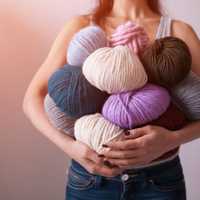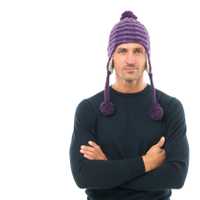Knitting Kits for Beginners
By Kelli A Delahoussaye
Knitting Kits for Beginners
By Kelli A Delahoussaye
If you are interested in knitting, then you need to know that there is more to it than needles and yarn. Every serious knitter should have a basic knitting kit. I'm going to show you what I have in my knitting bag. Since I am a visual learner and teacher, I'll show you what your basic knitting tool should include with pictures. So let's get started.
-
Basic Knitting Bag-So far I have two. One is a small project bag, such as scarves, hats, socks, etc. and the other one is for larger projects, such as sweaters and blankets. Since you will probably only be knitting smaller projects in the beginning, I would suggest you start out with a small project bag.
-
Tape Measure-You don't have to get anything fancy, just a basic tape measure. Some patterns will tell you to knit a certain amount of inches. For example: knit until you scarf reaches 35 inches.
-
Row Counter-This little guy is my lifesaver. Each time you finish a row, just twist it to the next number. I can't tell you how many times I've lost count on my rows and then realize I hadn't been keeping up. Sure you can count your rows, but if you're a beginner, then it can be difficult to understand.
-
Stitch Holder-I have used this in the past when I was working on a few projects at the same time and they required the same needle. This is kind of like a giant safety pin. When you want to move on to another project or just don't want to leave the stitches on the needle, then you can use this. Just transfer each stitch onto the stitch holder and then fasten. You don't have to worry about the stitches falling off.
-
Scissors-Again these don't need to be fancy. They just need to be sharp enough to cut yarn. I know a lot of big scissors will get dull and won't even cut butter, so just make sure they are sharp enough.
-
Large Tapestry Needle-These are used to weave in the ends and can also help with life lines. You want to make sure you get a large one so the yarn can fit the eye of the needle. I use this one for every project.
-
Knitting Gauge-You will use this to measure you stitches per inch. You will usually knit a swatch using the needle and yarn stated in the pattern. If you need to change the gauge, then you will need to change the needle sizes. Every one knits differently, so the directions on a pattern are only an estimate. Frankly, I've never used this because I haven't knitted a sweater and I see no point using it for scarves or blankets. This is still intimidating to me and I need to get more familiar with it.
-
Stitch Markers- When a pattern calls for place makers (pm) or slip marker (sm), then they are talking about these stitch markers. These will be often be used in circular knitting and when you need to keep track of your stitches. There are two types of stitch markers: Open (split ring) and closed, I prefer the closed because I don't have to worry about them falling off. The best thing about stitch markers is that they are cheap, plus if you don't want to go out and purchase them, then you can just use paperclips.
-
Cable Stitch Needle-These are used when you are making a cable pattern. When making a cable pattern, you will need to drop a few stitches and then knit the stitches after those stitches. The cable stitch needle will hold the dropped stitches temporarily until you need to knit them.
Once you get your basic knitting tool together, then you will be ready to start knitting. I always suggest getting these first because you don't want to start a project and then realize you need one of these items. I know for sure you will need the scissors, row counter, and the tapestry needle for every project. I hope you enjoyed the article and please feel free to comment.
Check out my Knitting Blog here: http://www.knittingwithwildlife.blogspot.com
Article Source: http://EzineArticles.com/?expert=Kelli_A_Delahoussaye
If you are interested in knitting, then you need to know that there is more to it than needles and yarn. Every serious knitter should have a basic knitting kit. I'm going to show you what I have in my knitting bag. Since I am a visual learner and teacher, I'll show you what your basic knitting tool should include with pictures. So let's get started.
-
Basic Knitting Bag-So far I have two. One is a small project bag, such as scarves, hats, socks, etc. and the other one is for larger projects, such as sweaters and blankets. Since you will probably only be knitting smaller projects in the beginning, I would suggest you start out with a small project bag.
-
Tape Measure-You don't have to get anything fancy, just a basic tape measure. Some patterns will tell you to knit a certain amount of inches. For example: knit until you scarf reaches 35 inches.
-
Row Counter-This little guy is my lifesaver. Each time you finish a row, just twist it to the next number. I can't tell you how many times I've lost count on my rows and then realize I hadn't been keeping up. Sure you can count your rows, but if you're a beginner, then it can be difficult to understand.
-
Stitch Holder-I have used this in the past when I was working on a few projects at the same time and they required the same needle. This is kind of like a giant safety pin. When you want to move on to another project or just don't want to leave the stitches on the needle, then you can use this. Just transfer each stitch onto the stitch holder and then fasten. You don't have to worry about the stitches falling off.
-
Scissors-Again these don't need to be fancy. They just need to be sharp enough to cut yarn. I know a lot of big scissors will get dull and won't even cut butter, so just make sure they are sharp enough.
-
Large Tapestry Needle-These are used to weave in the ends and can also help with life lines. You want to make sure you get a large one so the yarn can fit the eye of the needle. I use this one for every project.
-
Knitting Gauge-You will use this to measure you stitches per inch. You will usually knit a swatch using the needle and yarn stated in the pattern. If you need to change the gauge, then you will need to change the needle sizes. Every one knits differently, so the directions on a pattern are only an estimate. Frankly, I've never used this because I haven't knitted a sweater and I see no point using it for scarves or blankets. This is still intimidating to me and I need to get more familiar with it.
-
Stitch Markers- When a pattern calls for place makers (pm) or slip marker (sm), then they are talking about these stitch markers. These will be often be used in circular knitting and when you need to keep track of your stitches. There are two types of stitch markers: Open (split ring) and closed, I prefer the closed because I don't have to worry about them falling off. The best thing about stitch markers is that they are cheap, plus if you don't want to go out and purchase them, then you can just use paperclips.
-
Cable Stitch Needle-These are used when you are making a cable pattern. When making a cable pattern, you will need to drop a few stitches and then knit the stitches after those stitches. The cable stitch needle will hold the dropped stitches temporarily until you need to knit them.
Once you get your basic knitting tool together, then you will be ready to start knitting. I always suggest getting these first because you don't want to start a project and then realize you need one of these items. I know for sure you will need the scissors, row counter, and the tapestry needle for every project. I hope you enjoyed the article and please feel free to comment.
Check out my Knitting Blog here: http://www.knittingwithwildlife.blogspot.com
Article Source: http://EzineArticles.com/?expert=Kelli_A_Delahoussaye



